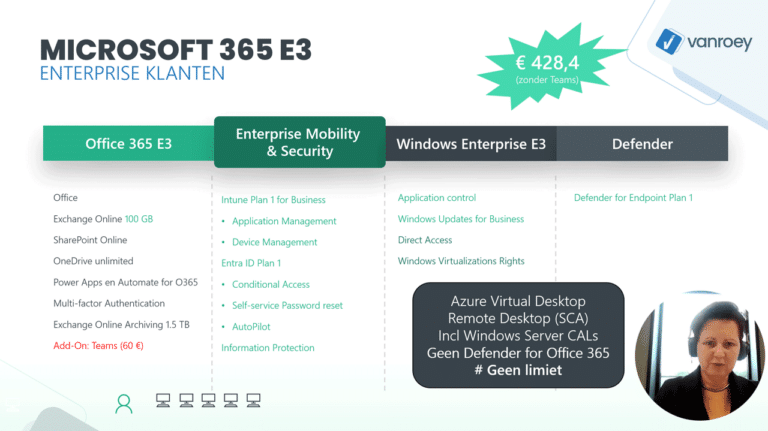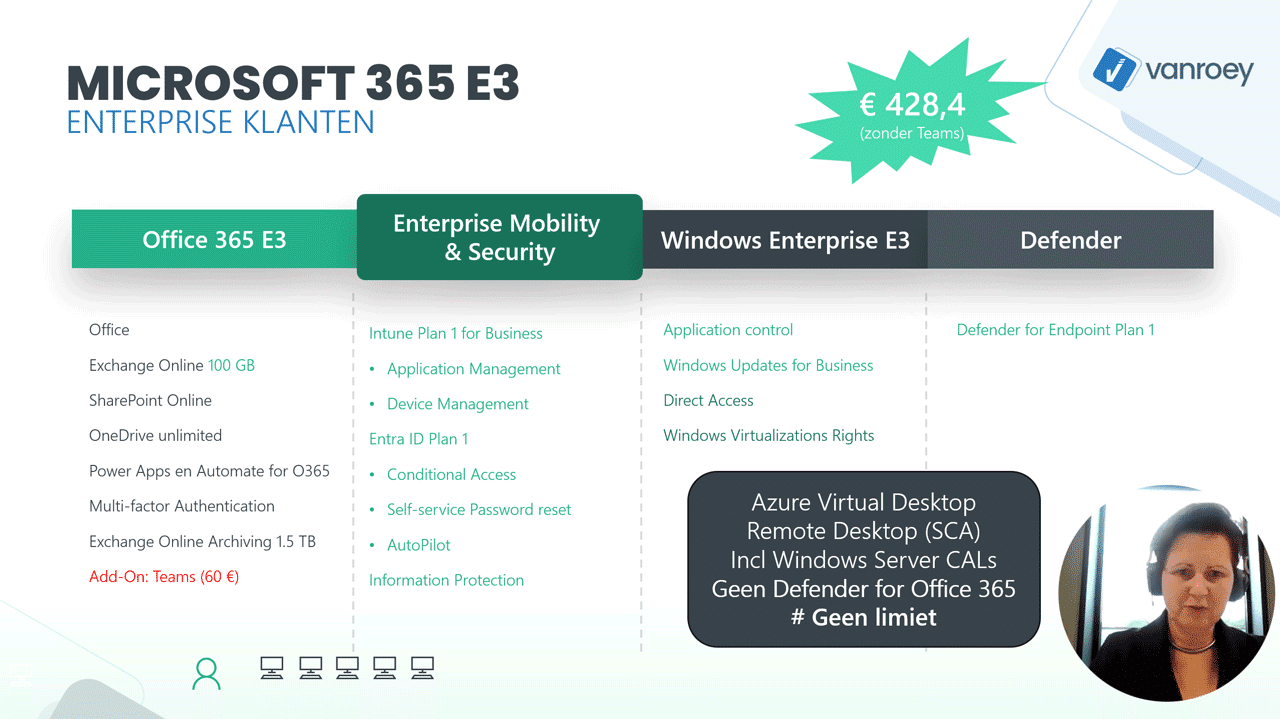Below, Ines shares some quick-wins to look at as an organisation:
Tip 1: Office 365 E3 > Microsoft 365 Business Premium
An example of a 'downgrade' is the switch from Office 365 E3 to Microsoft 365 Business Premium:
- What do you already have? Office, Exchange Online, Teams, SharePoint Online and OneDrive
- What do you submit? Oa. mailbox from 100GB to 50GB + OneDrive 1TB instead of unlimited
- What do you get extra? Security features such as: Microsoft Defender for Office 365, Azure Active Directory, Intune, Defender for Business, ...
Per user, this can save you around €70 on an annual basis! This is provided you don't need more than 300 licences.
Tip 2: Microsoft 365 E3 > Microsoft 365 Business Premium
An example of a 'downgrade' is the switch from Microsoft 365 E3 to Microsoft 365 Business Premium:
- What do you already have? Office, Exchange Online, Teams, SharePoint Online and OneDrive
- What do you submit? Windows Pro instead of Enterprise, no Windows Server CAL rights, less storage mailbox and OneDrive + some Microsoft security features less compared to Microsoft 365 E3.
Per user, this can save you around €200 on an annual basis! This provided you do not need more than 300 licences and no essential already configured security features are missing.
Tip 3: Microsoft 365 Business Standard > Microsoft 365 Business Premium
An example of a recommended 'upgrade' is the switch from Microsoft 365 Business Standard to Business Premium.
- What do you already have? Office (desktop), Exchange Online, Teams, SharePoint Online and OneDrive
- What do you get extra? Security features such as: Microsoft Defender for Office 365, Azure Active Directory, Intune, Defender for Business, ...
This for an extra €8.93 a month.
Tip 4: Microsoft 365 E1 > Microsoft 365 F3
A recommended 'downgrade' for organisations with many frontline employees is to switch from Microsoft 365 E1 to F3. This licence is ideal for employees who do not work at a PC all day, but still need access to their mailbox, SharePoint and OneDrive (in a secure way).
- What do you already have? Basic versions of Office web apps, Exchange Online, Teams, SharePoint Online and OneDrive
- What do you get extra? Access to productivity tools specifically tailored to frontline employees, including Teams communication capabilities and company portals
However, bear in mind the following with the switch to F3 restrictions:
- E-mail: The mailbox is reduced from 50 GB to 2 GB, with access via the web version of Outlook
- OneDrive: Storage capacity reduces from 1 TB to 2 GB per user
- SharePoint: F3 licences offer limited functionality, including no access to team mailboxes and personal sites (SharePoint Online Kiosk licence)
Still, it can provide significant savings for employees who mainly use mobile devices and do not need full desktop apps.
The Microsoft 'New Commerce Experience' (NCE) licensing model, introduced in February 2022 as a successor to the Cloud Solution Provider (CSP) programme, is now in use for almost two years. This model applies to licences of Office 365, Microsoft 365, Dynamics 365, Windows 365 and Power Platform, among others. For many organisations, 2025 is therefore the ideal time to critically reassess their licence use and optimise.
Moreover, its NCE rules now also apply to the non-profit and education sectors, which opens up new opportunities and focal points for these organisations.
These guidelines remain in force
There are several subscription options with various levels of flexibility and price protection benefits. Depending on the duration and type of subscription, specific conditions apply to billing, termination options and licence access.
The guidelines below remain in force and will help you choose the subscription that best suits your needs.
| Subscription 1 month | Subscription 12 months | Subscription 36 months | |
| Billing | Per month | Per month or year | Per month, year or 3 years |
| Prices | +20% | Standard | Standard |
| Commitment | Flexible | Fixed | Fixed |
| Cancel after 1 week? | 1 month charged | 12 months charged | 36 months charged |
| Price protection | 1 month | 1 year | 3 years |
| Interim upgrades | |||
| Interim downgrades | |||
| Which licences? | All subscriptions | All subscriptions except Windows 365 | Mainly Dynamics 365 |
Time for action!
As you can see in the equation above, 'Interim downgrades' are no longer allowed in any formula. Since most organisations opt for the 12-month licence model, now is the time - even before the expiry date - to downgrade and/or downgrade your licences where necessary.
Because from 7 days after the renewal date your licences are again fixed for 1 year! From then on, you can only:
- Upgrading your subscription
- Increase licences
- Changing billing frequency
- Apply co-term date
Applying for the necessary changes on time is therefore the message! Allow a few days for processing before the effective expiry date!
If price adjustments follow, it will be before April 2025.
Also be sure to take a look To our other blog posts!
More tips & tricks?
Would you like to explore extensively using sample scenarios What savings or upgrades your organisation can achieve? Then be sure to watch Ines' video. In 15 minutes, she explains all the options available:
share this post:



















